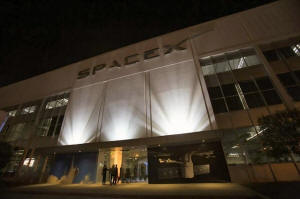|
Exclusive: SpaceX to hit fastest launch
pace with new Florida site - executive
 Send a link to a friend
Send a link to a friend
 [February 07, 2017]
By Irene Klotz [February 07, 2017]
By Irene Klotz
CAPE CANAVERAL, Fla. (Reuters) - Space
Exploration Technologies Corp, better known as SpaceX, plans to launch
its Falcon 9 rockets every two to three weeks, its fastest rate since
starting launches in 2010, once a new launch pad is put into service in
Florida next week, the company's president told Reuters on Monday.
The ambitious plan comes only five months after a SpaceX rocket burst
into flames on the launch pad at the company's original launch site in
Florida. SpaceX, controlled by billionaire Elon Musk, has only launched
one rocket since then, in mid-January.
“We should be launching every two to three weeks,” SpaceX President
Gwynne Shotwell told Reuters in an interview on Monday.
SpaceX was approaching that pace last autumn, before the Sept. 1
accident, which happened during a routine preflight test. The explosion
destroyed a $200 million Israeli satellite and heavily damaged the
launch pad.
Shotwell said repairs to the launch pad at Cape Canaveral Air Force
Station, which are still underway, should cost “far less than half” of a
new launch pad, which she said runs about $100 million. The new launch
pad is at NASA's Kennedy Space Center, just north of the Cape Canaveral
site.

SpaceX is also modifying the rocket's engines to increase performance
and resolve potential safety concerns, said Shotwell.
The company plans to change the design of the Falcon 9's turbopump -
which provides propellants to the rocket's engines - to eliminate cracks
that have prompted concern from NASA and the U.S. Air Force.
NASA has hired SpaceX to taxi astronauts to and from the International
Space Station starting in late 2018.
Shotwell said the new turbopumps will be installed before the first
unmanned test flights of the commercial space taxi, scheduled for
November.
SpaceX is one of two companies certified to fly military and national
security satellites for the Air Force, the other being United Launch
Alliance, a partnership of Boeing Co <BA.N> and Lockheed Martin Corp
<LMT.N>.
[to top of second column] |

An exterior of the SpaceX headquarters in Hawthorne, California May
29, 2014.REUTERS/Mario Anzuoni

“For us, the concern was not the cracks, but do they grow over time?
Would these cracks cause a flight failure?” Shotwell said. “I think
NASA is used to engines that aren’t quite as robust, so they just
don’t want any cracks at all in the turbo machinery."
SpaceX discovered two types of cracks during ground tests of its
Merlin engines in 2015, Shotwell said. The cracks were not related
to the Sept. 1 launch pad explosion.
To fix the more serious cracking issue, the company devised a
software fix and then redesigned the turbine wheel, Shotwell said.
The first of the redesigned turbine wheels flew in July 2016.
A second set of cracks in welds and shrouds are not a concern for
flight, but NASA and the Air Force have asked for a redesign,
Shotwell said.
SpaceX has a backlog of more than 70 missions, worth more than $10
billion. It has successfully flown 27 out of 29 times since the
Falcon 9’s debut in 2010.
The company flew eight missions in 2016 before the launch pad
accident in September grounded the fleet. The rocket returned to
flight last month, flying from a second launch site in California,
which is only used for satellites heading into polar or high
inclination orbits.
A fourth launch site in Texas is under construction.
(Reporting by Irene Klotz; Editing by Bill Rigby)
[© 2017 Thomson Reuters. All rights
reserved.]
Copyright 2017 Reuters. All rights reserved. This material may not be published,
broadcast, rewritten or redistributed.
 |